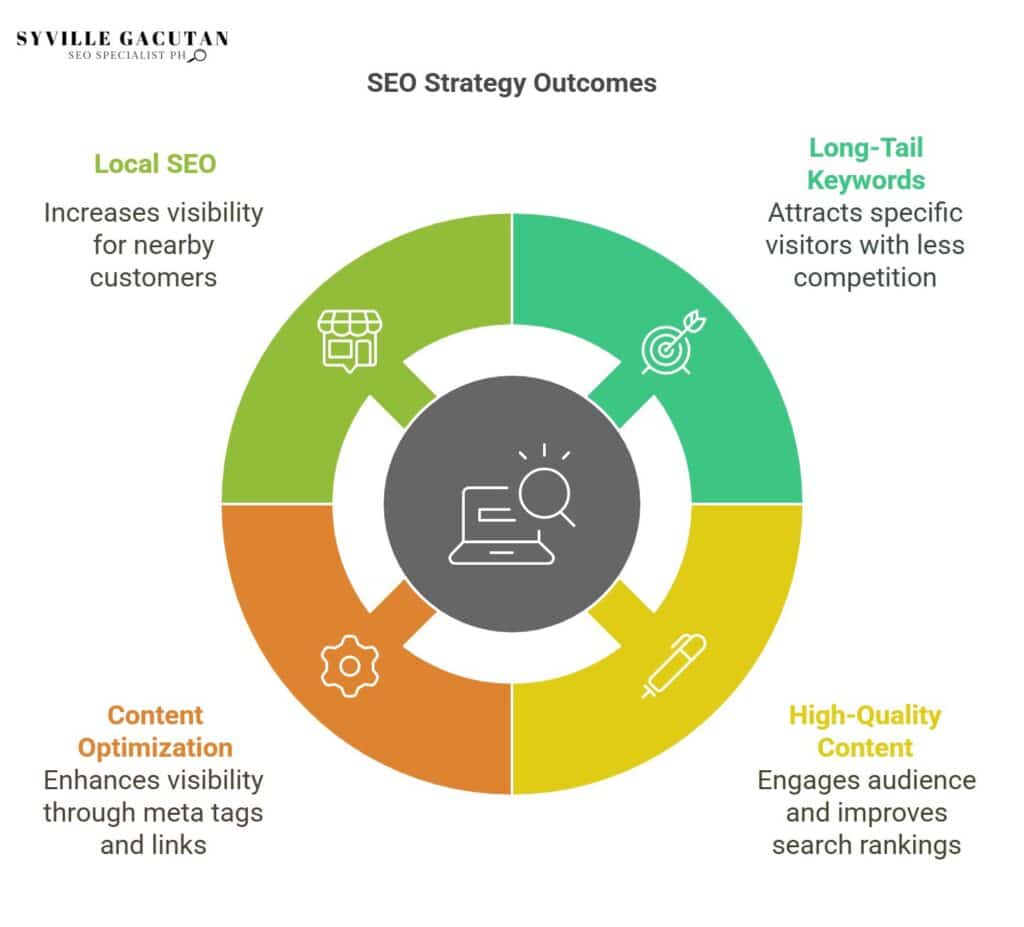
Cost-Effective SEO Keyword Optimization: A Step-by-Step Guide
To optimize your SEO keywords without spending too much, start by using affordable tools like Google Keyword Planner, Ubersuggest, and AnswerThePublic for thorough keyword research. By focusing on long-tail keywords, you can attract a more targeted audience and improve your conversion rates. Create high-quality, keyword-rich content and encourage user-generated content like reviews. Optimize existing content by refining meta tags and internal links. Leverage free tools to maximize budget and incorporate local SEO to attract nearby customers. Monitor performance using analytics to continually refine your strategy. Explore further to know how to optimize SEO keywords cheaply and elevate your digital presence and drive organic traffic efficiently.
Key Takeaways
- Conduct thorough keyword research using free or low-cost tools to identify relevant, high-impact keywords.
- By focusing on long-tail keywords, you can attract more specific and interested visitors to your site. This approach faces less competition and increases your chances of turning visitors into customers, improving your conversion rates.
- Craft compelling, high-quality content that naturally incorporates keywords and truly resonates with what your audience is seeking; this will help improve your search engine rankings.
- Optimize existing content by refining meta tags, headings, and internal links to boost visibility and performance.
- Leverage local SEO with location-based keywords to attract nearby customers and enhance local search visibility.

Step 1: Affordable Keyword Research Tools

When you’re starting out with an SEO strategy, choosing the right keyword research tools is really important for your success. The tools you select can make a big difference, helping you understand what your audience is searching for so you can create content that truly connects with them. When you opt for affordable keyword research tools, you gain essential insights without overextending your budget. This approach empowers businesses of all sizes to compete effectively in the digital marketplace.
These tools are indispensable for keyword research for SEO, offering valuable data on search volume and competition.
A tool worth highlighting is Google’s Keyword Planner. Though it was originally designed for AdWords campaigns, it has become a favorite among SEO professionals because of its extensive database and free access.
A great tool to consider is Google’s Keyword Planner. Originally created for AdWords campaigns, it’s become a favorite among SEO professionals because it’s free and has a huge database to draw from.
Another effective keyword research tool is Ubersuggest by Neil Patel. Known for its user-friendly interface and comprehensive features, Ubersuggest offers suggestions, search volume metrics, and competitive analysis.
Its affordability makes it an excellent option for businesses seeking to maximize their SEO efforts without incurring substantial costs.
AnswerThePublic is another valuable asset for conducting effective keyword research. This tool visualizes search queries, providing insights into the questions and phrases users commonly enter into search engines.
This understanding can guide content creation, ensuring it aligns with user intent and improves search engine rankings.
Lastly, Keywords Everywhere is a browser extension that integrates seamlessly with search engines. It offers search volume, competition data, and cost-per-click information directly on search engine results pages, making keyword research efficient and straightforward.
Step 2: Low-Cost SEO Keyword Strategies

Crafting effective SEO keyword strategies on a budget requires a combination of creativity and strategic planning. For businesses seeking to maximize their online presence without overspending, adopting low-cost SEO keyword strategies can yield impressive results.
The cornerstone of a cost-effective SEO approach is thorough keyword research. Identifying relevant keywords that resonate with your target audience is crucial, as it sets the foundation for all subsequent optimization efforts.
A robust keyword research strategy begins with understanding your audience’s search behavior. Utilize free or affordable tools to uncover high-impact keywords with low competition. Long-tail keywords, which are more specific and less competitive, often provide a golden opportunity for low-cost SEO. These keywords not only attract a more targeted audience but also enhance the likelihood of higher conversion rates.
Content creation is another pivotal element in a low-cost SEO strategy. By producing high-quality, keyword-rich content, you can naturally improve your search engine rankings. Regularly updating your blog or website with relevant articles, guides, and tutorials helps maintain engagement and signal to search engines that your site is active and valuable.
Leveraging user-generated content is another cost-effective tactic. Encouraging reviews, testimonials, and social media interactions can generate fresh content and incorporate keywords organically.
Additionally, optimizing existing content by refining meta tags, headings, and internal links can boost search visibility without incurring significant costs.
Step 3: Budget-Friendly Keyword Optimization

How can businesses effectively optimize keywords on a limited budget? Achieving budget-friendly keyword optimization begins with comprehensive keyword research. Utilizing free or low-cost tools like Google Keyword Planner or Ubersuggest can help identify high search volume keywords that are relevant to your industry. These tools provide valuable insights into search trends, competition levels, and potential opportunities to capture organic traffic.
Effective SEO strategies on a limited budget also involve focusing on long-tail keywords. These are more specific and typically have lower competition than broad keywords, making them easier to rank for. By targeting long-tail keywords, businesses can attract highly targeted organic traffic without the need for extensive financial investment.
Another essential aspect of budget-friendly keyword optimization is content creation. High-quality, relevant content can significantly enhance your website’s SEO performance. Regularly updating your site with blog posts, articles, and other content types that incorporate your targeted keywords can improve your search engine rankings. This strategy not only helps in optimizing your keywords but also in keeping your audience engaged.
In addition, consider optimizing existing content. Conduct an audit to identify underperforming pages and refresh them with up-to-date keywords and information. This is a cost-effective strategy to boost your organic traffic without creating new content from scratch.
Lastly, leveraging social media platforms can amplify your efforts. Sharing your optimized content on social media can drive additional traffic to your site, indirectly boosting your SEO performance.
Step 4: Maximizing ROI with Keywords

Building upon budget-friendly keyword optimization strategies, businesses can further enhance their efforts by focusing on maximizing the return on investment (ROI) with keywords. Effective SEO is not solely about driving traffic; it’s about driving the right traffic that converts into tangible business results.
To achieve this, businesses need to adopt a keyword strategy that balances cost-effectiveness with high performance.
To maximize ROI with keywords, start by conducting thorough keyword research. Identifying high-value keywords that align with your business goals and target audience is essential. This involves analyzing search volume, competition, and relevance to ensure that the selected keywords have the potential to drive quality traffic.
Here are some key strategies to maximize ROI with keywords:
- Focus on Long-Tail Keywords: Long-tail keywords often have lower competition and higher conversion rates. These specific, targeted phrases can attract users who are closer to making a purchasing decision.
- Analyze and Optimize Performance: Continuously monitor the performance of your keywords using analytics tools. Optimize your keyword strategy based on what’s driving the most conversions, not just traffic.
- Leverage Local SEO: If your business operates locally, incorporating location-based keywords can help attract nearby customers who are more likely to convert, enhancing your cost-effective SEO efforts.
- Integrate Keywords Across Channels: Utilize your chosen keywords consistently across various marketing channels, including social media, email campaigns, and content marketing, to create a cohesive and effective SEO strategy.
Step 5: Utilizing Free Tools for Keyword Research
When embarking on an effective keyword strategy, leveraging free tools for keyword research can significantly enhance your approach without straining your budget. These tools provide invaluable insights, allowing you to conduct keyword research efficiently and optimize your website for better search engine rankings.
One of the most popular keyword research tools is Google Keyword Planner. As part of Google’s advertising platform, it offers a wealth of data on keyword search volumes, trends, and competition levels. This tool is particularly useful for identifying high-potential keywords that align with your target audience’s search behavior.
By using Google Keyword Planner, you can refine your keyword strategy to ensure you are targeting the terms that will drive the most traffic to your site.
Another excellent option is Ubersuggest, a versatile tool that not only generates keyword ideas based on your seed term but also provides data on search volume, competition, and seasonal trends. This information is crucial for tailoring your content strategy to meet the needs of your audience effectively.
Additionally, tools like AnswerThePublic can help you understand the questions and phrases people are using in search engines. This tool visualizes search queries and provides a comprehensive list of related keywords, enabling you to create content that directly addresses your audience’s concerns and interests.
Using these free tools for keyword research allows you to conduct a thorough analysis without incurring high costs. By integrating insights from these keyword research tools into your SEO strategy, you can optimize your website, improve your search engine rankings, and ultimately drive more organic traffic.
Step 6: Optimizing Keywords on a Budget

Leveraging free tools for keyword research is a great starting point, but effectively optimizing keywords on a budget requires strategic implementation and ongoing management. When resources are limited, it’s essential to make every effort count to ensure cost-effective SEO.
Here are some practical tips to help you optimize keywords without overspending.
First, prioritize long-tail keywords. These specific phrases often have lower competition and higher conversion rates. By targeting long-tail keywords, you can achieve better rankings and drive more targeted traffic to your site, which enhances overall SEO performance.
Second, utilize free keyword research tools like Google Keyword Planner, Ubersuggest, and AnswerThePublic. These platforms provide valuable insights into search volume, competition, and related keyword suggestions, enabling you to make data-driven decisions without incurring costs.
Third, focus on optimizing on-page elements. Ensure that your chosen keywords are naturally integrated into titles, meta descriptions, headers, and content. This helps search engines understand the context of your pages, boosting your visibility and relevance.
Fourth, leverage user-generated content. Encourage reviews, comments, and forum participation on your website. This not only enriches your content but also introduces naturally occurring keywords that can improve your site’s SEO performance.
In summary, optimizing keywords on a budget involves a calculated approach that maximizes available resources. By focusing on specific strategies and leveraging free tools, you can achieve cost-effective SEO outcomes.
Here are some actionable steps:
- Prioritize long-tail keywords to target specific, less competitive phrases.
- Utilize free keyword research tools for valuable insights.
- Optimize on-page elements to improve search engine understanding.
- Leverage user-generated content to naturally enrich keyword diversity.
These steps will help ensure that your SEO efforts remain both budget-friendly and effective.
Final Thoughts
Cost-effective SEO keyword optimization is essential for businesses aiming to enhance their online presence without overspending. By utilizing affordable tools and focusing on long-tail keywords, companies can attract a targeted audience and improve conversion rates. Crafting high-quality content, optimizing existing material, and leveraging user-generated content are vital strategies that not only enhance visibility but also engage users effectively. Monitoring performance and continuously refining keyword strategies ensures that businesses adapt to changing trends while maximizing their return on investment.
If you’re ready to achieve cost-effective SEO results without compromising quality, connect with Syville Gacutan, an experienced SEO Specialist in the Philippines. Syville can help you identify high-impact keywords, optimize your content, and drive targeted traffic to your website—all within your budget. Don’t miss the opportunity to enhance your online presence—reach out today!